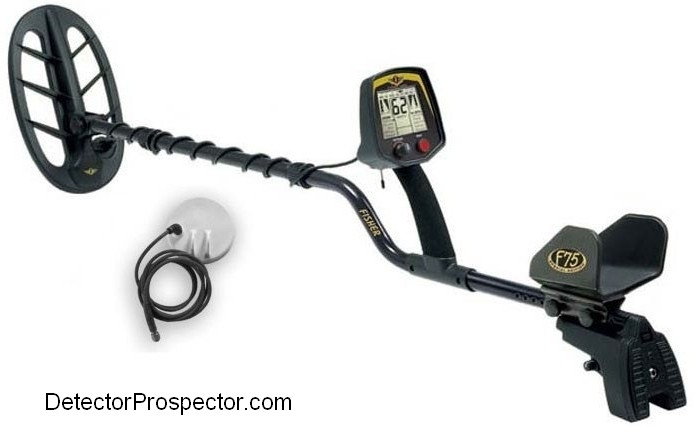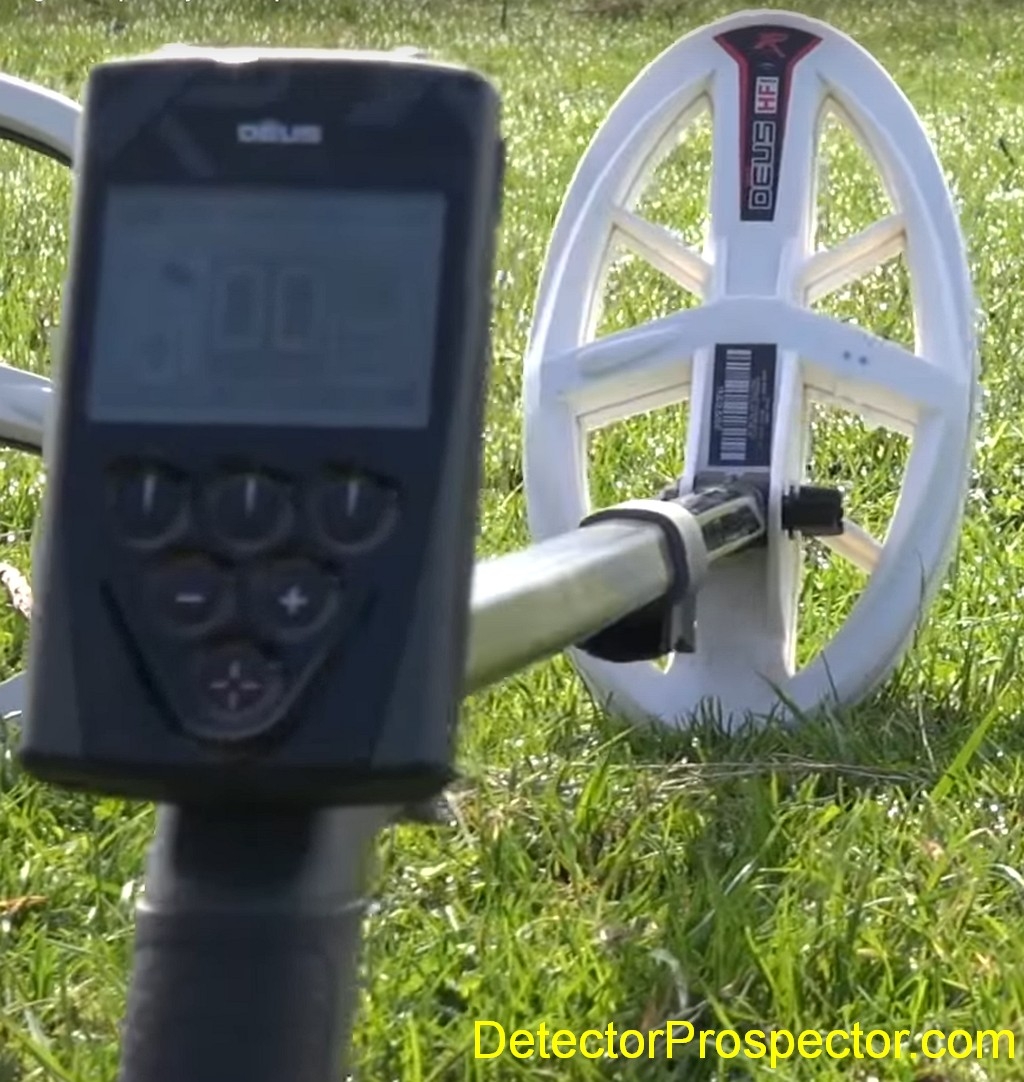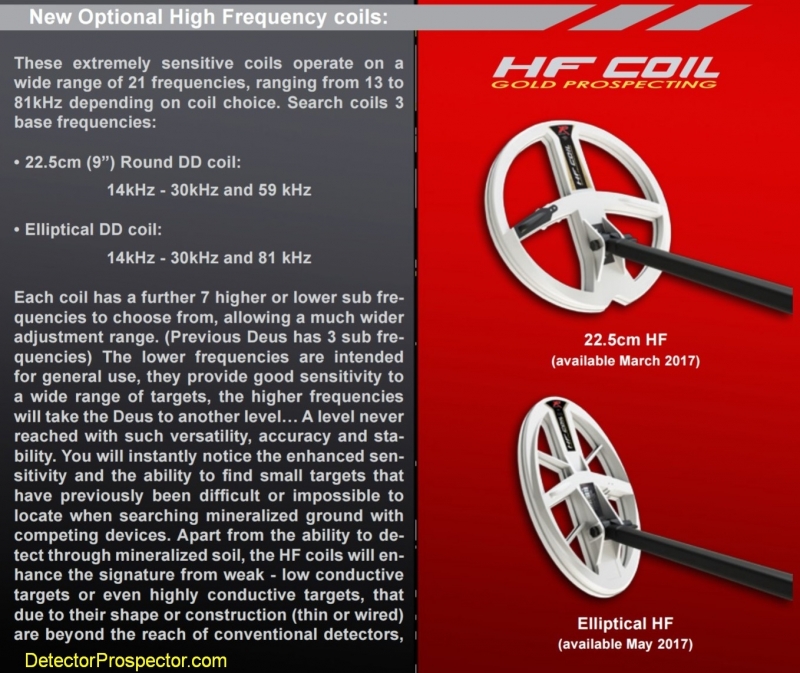-
Posts
19,805 -
Joined
Content Type
Forums
Detector Prospector Home
Detector Database
Downloads
Posts posted by Steve Herschbach
-
-
At least one Australian dealer is selling what is being called the XP Deus "GoldField" High Frequency Gold Package. This is a fairly normal Deus setup but with the 9" round high frequency coil. Items included:
- XP Deus Full Featured Remote control Unit. (Ten Built in Programs including Gold field with one touch ground balancing.)
- XP Deus 9 Inch (22.5cm) HIGH Frequency coil - The white one. (15, 30 and 55 kHz + 7 Shifts for each, 21 frequencies total)
- S-Shaped Telescopic shaft.
- 240V Charger with 3 way cable
- Arm Band
- 2 sets of coil connecting hardware
- User manual
- Hip Mount case for Remote control
- 5 Year Warranty
- FREE FX-02 Wired Backphones
Priced at $1899 Australian (US$1415.00)
I do not know if this is going to be a standard package or is just something the Aussie dealer put together, but it would make sense for XP to offer HF coil package options since they do it for other coils. There may end up being an elliptical coil version and possibly even a version like the Depar DPR 600
Even at $1400 the HF Deus is a lot more money than something like the Minelab Gold Monster but the DPR 600 would be much more price competitive with dedicated nugget detectors should XP choose to market it outside Africa.
September 2018 - New XP ORX announced.
-
Not too many videos hold my interest. I liked the Deus V4 HF Coil video Gary did. I only want hard core detector info but that's just me. Others probably find that dry and boring and want to see finds. The videos White's made for a lot of their detectors like the MXT video are quite good - more like a video alternative to the Owners Manual that illustrates detector functions and settings. Great for people who never read manuals and good for people thinking of buying them.
-
-
Excellent - yup, I remember leaving those there!
-
You guys are too funny
 . Good news is I left LOTS of gold at Crow Creek Mine. Below is typical of what I might find metal detecting at Crow Creek. Wish I had some brilliant tips besides just work hard at it and good luck! The best advice I can offer anyone who has not been there is to read my Crow Creek stories at Steve's Mining Journal
. Good news is I left LOTS of gold at Crow Creek Mine. Below is typical of what I might find metal detecting at Crow Creek. Wish I had some brilliant tips besides just work hard at it and good luck! The best advice I can offer anyone who has not been there is to read my Crow Creek stories at Steve's Mining Journal
-
Back by popular demand and priced $100 less, the White's M6. The M6 is an extremely simplified White's MXT variant, and although it may be simple the MXT power is still there. See my early M6 review here.
White's M6 metal detector features
White's M6 metal detector diagram and controls -
The basic trade is recovery versus portability, but possibly made up for by volume. A subsurface can weigh far less and cost less to build, and employ a smaller motor burning less fuel than the equivalent surface dredge. So for short in and out trips to hard to reach locations they can be great. The longer term the operation, the less sense a subsurface makes.
The volume trick is this. I can use a 6hp pump to make a good 4" surface dredge, or a 5" subsurface about the same size and weight, same fuel consumption. The 4" gets a better recovery per yard, but the 5" can move twice the yards. That means recovery can suffer quite a bit and you still have more gold. If you have the time, get all the gold out of every yard you can. But if you have two weeks a year you might get more gold for your time spent by going for volume, depending on the nature of the deposit. Obviously the coarser the gold the better for a subsurface. If the gold is fine or flat/flaky enough a subsurface could basically just lose all of it - not good.
No real right or wrong here, just different approaches for different situations. I have used subbies a lot and been very happy overall with what I was doing with them. More in depth discussion here.
-
I charge my GPZ every night so not really an issue for me. Even two days sounds good from that perspective.
-
4 hours ago, Ridge Runner said:
That is harsh words for the MX Sport. The question I have for you have you ever had a MX Sport ?
Yeah, actually Shelton did have an early MX Sport with the issues. Not everyone is required to be forgiving and put up with problems to the degree you did Chuck. It was a flawed release and this is the price White's pays for that.
On the other hand to the best of my knowledge White's ironed out all the issues finally and the MX Sport is now a stable performer at a good price. Sheltons opinion may not reflect the latest release of the machine, but he is certainly entitled to his opinion. My request to all - don't shoot the messenger.
-
Social media is less about information and more being seen. Hey, look what I had for lunch! Picture of my dog! Found this metal detecting!
Forums get that also but for me at least I scout forums for hard core technical information and other things that can help me be successful. I am not convinced that is a young person versus older person thing. Personally I see the social media channels more as entertainment but unless I am missing it I just don't seem to find any real meat that satisfies me on social media. It's like a lake a mile wide and an inch deep.
Different strokes for different folks I guess.
-
Glad you got it sorted out Mark though not great that the coils are not spot on. It always makes me wonder how many people are running detectors with substandard coils and don't know it. How many internet arguments over which detector is best are rooted in the same issue?
-
I would be the first person in the world to say that a good $500 - $700 VLF is all anyone really actually needs. I will never look down on anyone making that choice. I personally don't go that route however. I can tell myself all day long that the F70 is a far more sensible better but for the buck, but in the end I want the F75 with bells and whistles. We all have different perceptions of what represents a best value. I am of the opinion that picking good locations, knowing whatever machine you have well, and putting in the hours is what really matters. Ultimately though my time is more valuable than anything else so spending a little more to have those top end units works for me.
-
Well I have posted on this forum quite a bit about the F70 with notes as to how it relates to the F75 and will let those past posts speak for themselves. As far as the TNet thread goes my sole purpose in posting the link to it was to illustrate how messed up the whole issue of past versions can get. And therefore my advice when buying a used F75 and less so but also the T2.
-
Yeah I get to my page also just fine. Go to Your Page Fred and click on the article links. What happens?
-
To the best of my knowledge all solid black F75 models are the Special Edition (but usually referred to as Limited Edition) model. I am not as well up on the T2 versions. Of note concern would be what software version are you dealing with? There is a can of worms! I think we are at version 9.0/9.1 as of now.
We also have a monkey wrench in the form of upgrades done on standard models that can really confuse things.
I have to say that I am not shy of buying used detectors and do it a lot. Some models though there are just too many weird changes. And do keep in mind that the First Texas warranty is not transferable. If it was me I would probably get a deal someplace on a new full warranty unit as there were just too many versions and frankly, issues, in the past history of the F75 in particular. T2 not so much but still... be careful.
When I get time I am going to research and do a detailed chronology on this subject if somebody else has not already. If anybody finds a link to such a thing please post it. Here is one to show how complicated the issue has become.

-
It goes to the very heart of what "induction balance" is all about. The V3i and its related documentation is a virtual class on induction balance technology and how it works. From Spectra V3i Advanced Users Guide by Carl Moreland, page 3-2:
"V3i uses induction balanced loops which rely on a “null” between the transmit coil and the receive coil. The quality of the null may determine the point at which the detector overloads, especially when running Tx Boost along with high Rx Gain settings. Null quality varies loop-to-loop, so some loops may overload at lower gain than others."
And from Coil Basics by Carl Moreland, page 2:
"a second coil can be placed such that it inductively couples with the transmit coil. By careful placement, we can also get the second coil in a “null” of the transmit field, such that there is no coupling. In such a case we say the coils are inductively balanced, and this is where the term “induction balance” (IB) comes from."
The V3i pushes coil design hard by running separately at three different frequencies at high TX output. Each frequency must be separately nulled for optimum performance. There are ways to fudge which makes coils appear to work fine but which result in degraded performance. I can slap a 13 kHz F75 coil on my 19 kHz G2 and have it appear to work fine, but the fact is there will probably be ground balance and target VDI issues.
It is stuff like this that makes a layman like me question how Garrett can be getting optimum performance with AT coils on detectors running at 13.6, 15, and 18 kHz? Just how far can this be stretched?
The X-Terra models show how a detector can sense and compensate for different individual coils tuned for different frequencies. In theory this has a better end resultant than than trying to get one coil to run best at three different frequencies. In Garrett's case the coils are all the same, probably wound for 15 kHz but with loose enough tolerances that 13.6 and 18 kHz are within an allowable range of offset, and with possible electronic compensation going on in the circuitry. Just a guess on my part however it is this sort of fine tuning that does make or break those "edge of performance" differences between VLF detectors these days.
-
48 minutes ago, GB_Amateur said:
One thing I've wondered about is variation among (nominally) identical devices
There is certainly variation in older detectors and current analog models. Far less with modern surface mount digital models. Coils however are always an issue, especially older ones, and especially DD coils on very high performance models like the V3i. The higher the frequency, the harder to get it right.
The V3i coil has to be nulled at three frequencies and it is usually the 22.5 kHz frequency that fails.
-
9 hours ago, strick said:
Is the minelab ferrite ring any different then just any old ferrite ring?
From the Minelab Knowledge Base Article at http://www.minelab.com/__files/f/274444/KBA_26-1%20GPZ%207000%20Tips%20for%20Better%20Ground%20Balance.pdf
"A ‘dust iron’ toroid suitable for the HF frequency band (e.g.1–30MHz with an initial permeability of between 6 and 10) has been carefully selected. It is recommended to use this specific Minelab accessory, only. Alternate ferrites may significantly degrade ground balance quality."
You can get the ferrite ring at the link provided by Hawkeye above. Timely, as I just had a discussion with Minelab about the difficulty in finding misc parts. Since all GPZ detectors have been supplied with this part as a standard item for some time dealers probably get no demand for them.
-
I assumed you knew this stuff Mark but I always toss in extra info on threads for those who may not know.
White's D2 coils had a high failure rate early on. This link has information on how to test the coils. http://forums.whiteselectronics.com/showthread.php?55295-V-rated-coils-not-common-available
Good coils should be able to run RXG=15 with Tx Boost=On without overloading in an air test. If an overload occurs running the V3i separately in each frequency will reveal at which frequencies the coil is failing at (it could be all three).
-
Air tests can tell you if you have a bad machine/coil. They can tell you the best you can hope for in very low mineral ground. And as the link I provided clearly shows, air tests can offer some real clues as to what modes or settings might be worth exploring in the field.
The biggest thing air tests can't tell you is exactly what you have already mentioned johndoe - how well does the detector eliminate ground effects? I have seen one detector air test better than another detector and then have the results flip to the exact opposite in a ground test. There is almost nothing more important than how well a detector eliminates the ground. The worse the ground is that you work in, the more important this is. So while air tests can teach many things one thing they really can't tell you is how the detector performs in bad ground. In fact, some of the machines that air test the best do the worst in the ground!
-
The ferrite method is to insure the GPZ gets a proper ferrite sample to work with, which it needs to achieve a good ground balance. Most ground has naturally occurring ferrite and in such ground the naturally occurring ferrite does the job. People who normally work in this type of ground use the ferrite ring and see no real improvement, and that is where the confusion starts about the benefits.
However, there is ground that lacks enough ferrite to provide that needed reference point, and this is when using the ferrite ring is critical. You could try and guess when those ferrite free ground situations occur, and just use the ferrite ring then, but the fact is you just don't know. Safe answer - use the ferrite ring.
-
I am going to update this thread/post with links to any reviews of the Deus HF coils I can find as they appear. Remember, the high frequency (HF) coils only work with V4.
Andy Sabisch 9" HF Coil Review
Condor - First Impressions 9" HF Coil
Condor - Second Outing 9" HF Coil
Condor - Third Outing 9" HF Coil
Aussie Detectorist Gives 9" HF Coil A Go
Paul(CA) Tries The 9" HF Coil In Thick Iron Trash
-
Condor is doing a great job reviewing the 9" HF Coil. I am starting another thread collecting all the review links.
At this point it is very tempting for me to just get the 9" HF round as currently all I have is the 11" and so that would not be a half bad combo. But then I would still want the elliptical! My main worry now is that there is an issue holding it up, and that makes me leery of getting one ASAP anyway. At least the 9" seems to be a stable release. Whatever, it's just detectors and since we all have detectors already, probably too many, it just is not that big a deal. I will continue to wait for the elliptical.

-
Welcome to the forum!
Older GPZ threads are in the GPZ 7000 Archive
More recent threads that have not made it to the archive yet (those posted in the last year) can be found using the GPZ 7000 Tag
You can get very specific on finding information on specific subjects by using the Advanced Forum Search
For instance here is the result GPZ 7000 Ferrite
The modes and tuning methods people use are specific to their locations and hunting habits. Two people each using a GPZ 7000 at the same location may have vastly different ideas about what settings are best and how to set the machine up. Truthfully this subject has been discussed in great detail on the forum so do please avail yourself of the resources above. I unfortunately am on another mission right now so will leave it there and for others to chime in.



Coils For Caliche
in Detector Prospector Forum
Posted
Caliche is usually calcium carbonate and is normally invisible to a metal detector.